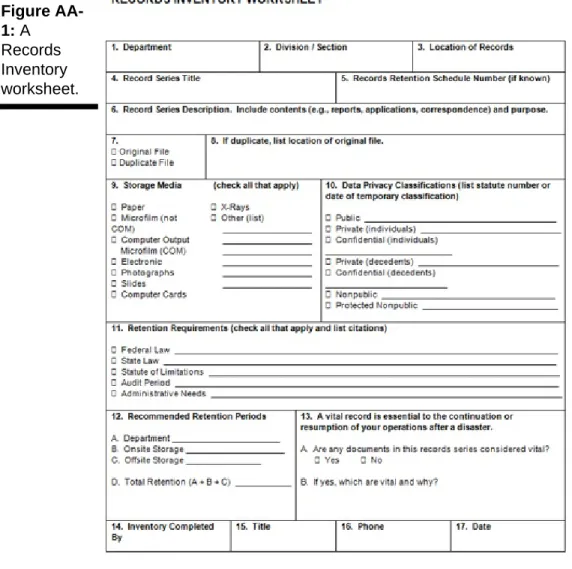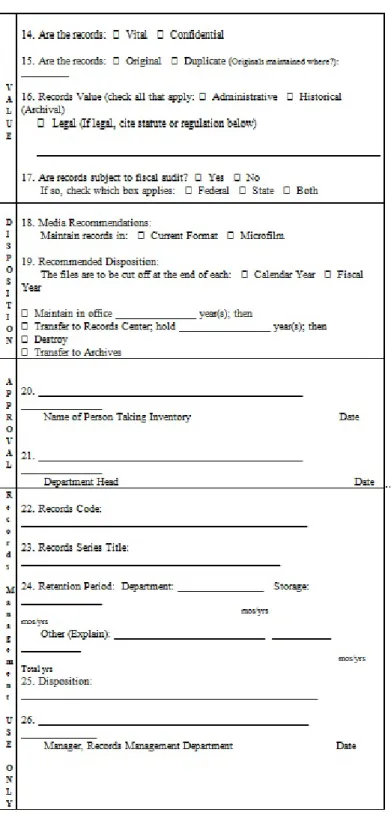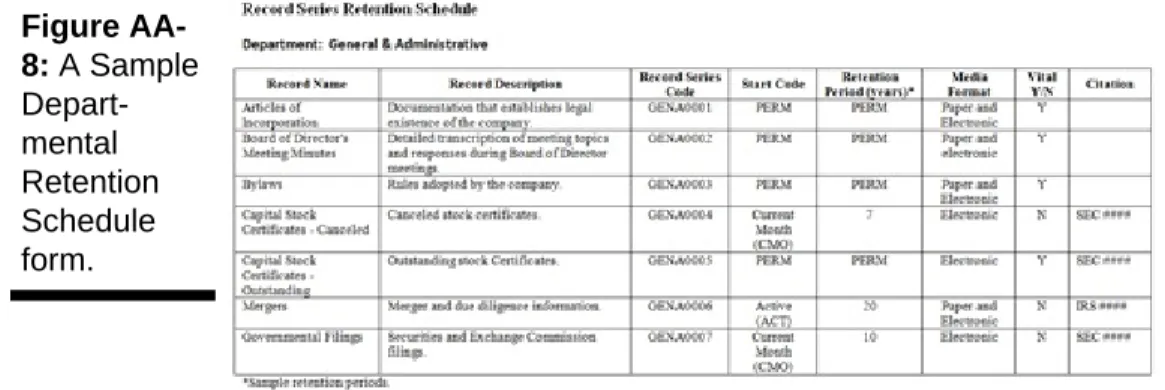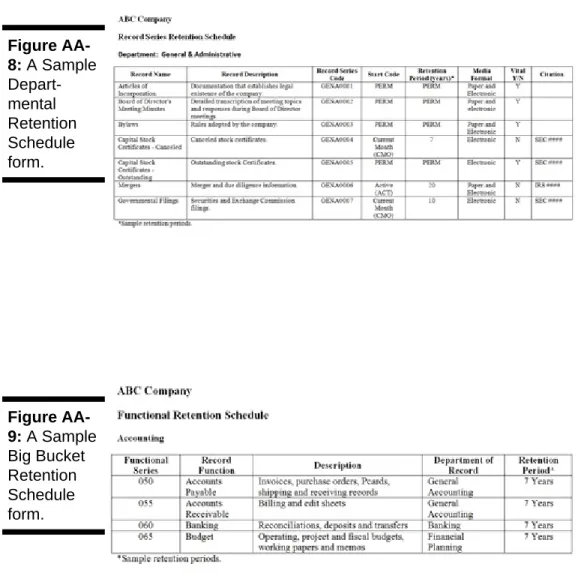How This Book Is Organized Part I: Setting the Stage II. part: Simplified filing III. part: Capture of records IV. Part: Parking spaces Part V: Creating a plan VI. part: Part Tens Bonus Contents: Appendix Dos and Don'ts Read the icons used in this book. Where Next, Part I: Setting the Stage. Creating a Retention Schedule Document Parts of the Retention Schedule Puzzle Sample Retention Schedule Forms.
Codifying the Policies
Ten Simple Management Guidelines Limiting E-Mail Attachments
Ten Emerging Trends
THIS WORK IS SOLD WITH THE UNDERSTANDING THAT THE PUBLISHER IS NOT ENGAGED IN PROVIDING LEGAL, ACCOUNTING OR OTHER PROFESSIONAL SERVICES. FURTHER, READERS SHOULD BE AWARE THAT INTERNET WEBSITES LISTED IN THIS WORK MAY HAVE CHANGED OR.
About the Author
Dedication
Acknowledgments
Publisher’s Acknowledgments
Introduction
About This Book
Conventions Used in This Book
Foolish Assumptions
How This Book Is Organized
The book is also given to readers who want to focus on particular topics or simply want to refresh their knowledge.
Setting the Stage
Filing Made Simple
Capturing Records
Parking Spaces
Creating a Plan
The Part of Tens
Bonus Content: Appendix
What You’re Not to Read
Icons Used in This Book
Where to Go from Here
I Know It’s Here Somewhere
Filing Methods
The more factors you consider now, the less paperwork you'll have to go through in the future.
The alpha file
The numbers don’t lie
Unlike alphabetical registration, correct numerical registration requires cross-referencing. sometimes referred to as indirect access). Before you implement a direct number recording system, you must determine which number is unique to the record you are filing.
Filing alphanumerically
By cutting down the amount of numbers and their corresponding folder label colors, you can efficiently retrieve and file without considering each number.
Evaluating Filing Equipment and Supplies
The following sections give you the insight you need to evaluate archiving equipment, methods, and supplies.
The right equipment makes a difference
Vertically challenged
Less capacity: Vertical file cabinets provide up to a third less capacity than other types of equipment. Space requirements: Vertical file cabinets require a lot of space when the drawers are open.
Taking a lateral approach
Side filing cabinets are ideal for offices that (a) process significant amounts of paper that must be retrieved frequently and (b) need to optimize their space. More capacity: Lateral filing cabinets are designed to hold up to a third more volume than vertical filing cabinets.
Keeping an open mind
Less space: Although side file cabinets are wider than vertical file cabinets, they are not as deep, which has a positive effect on the space needed for aisles. Easy access: open shelves have no drawers, so file folders are always accessible.
Making the most of it
Open-face shelving is typically used in an office environment that experiences frequent filing and retrieval, such as a medical office that houses patient medical records or a law office with client case files. If you use open-face shelving, it is recommended that the shelving units and information reside in an area that can be secured and accessible only by authorized employees.
File folders under “important”
Top-tab
Side-tab
More Styles: Side tab folders offer more style choices than other folder options, allowing an organization to tailor its filing. Better suited for floor space optimization plans: Side tab folders are suitable for use with the types of lateral filing cabinets (flip-top), open-face and mobile shelving, which require less office space.
Hanging with the hanging folder
Folder labeling
Label barcodes can be scanned with a handheld barcode scanner when folders are removed from a shelf, handed to an employee or placed face down on a shelf. Used with spreadsheet, database, or records management software, barcodes can allow you to know the location or status of a file.
Selecting a Filing Method
In addition to the different label types, you also have the option of computer generating your labels. I recommend that you computer-generate your labels whenever possible—and the label sheets that you can pick up at any office supply store make this easy.
Creating a records profile
Choosing the right filing method can improve employee efficiency, customer service, and compliance with laws and regulations. I will work hard in the following sections to ensure that you have the information you need to make the right choice.
Growing, growing — gone!
Forecasting file growth can help you determine the right storage method and how much equipment and floor space you will need. In some cases, this may result in the need to abandon your current storage method for one that is more suitable for your data volume.
Evaluating the current state of affairs
Another important factor to consider when implementing an archiving system is the need to account for growth. Plus, it can mean you don't have enough space to archive your records, affect your budget—hey, buying multiple filing cabinets costs money—and cause a decrease in employee productivity due to cluttered filing equipment.
Creating a Digital Filing System
In many cases, these symptoms are caused and can be mitigated by record lifecycle management. Regardless of the record type, each has an active and inactive period (life cycle phase).
Drawing the parallels
When creating an electronic filing system, it is important that you decide where your records will be filed. This means that you can create an electronic filing structure so simplified that it allows you to immediately file a document.
Naming folders and files
Conversely, you can create an electronic archiving structure with so many subfolders that it takes too long to archive, but you can immediately determine the location to retrieve them. If you're trying to retrieve a document that you know was from the previous month, you can do that.
Watch Out, I’m Backing Up
Creating a Backup Plan
Identifying different types of backups
IT departments of large organizations typically perform backups during off-peak hours (overnight and early morning) to ensure that all systems are functional and accessible during normal business hours. Based on the significant volume of data that large organizations are required to backup and store, organizations are constantly evaluating new techniques, media and applications to shorten backup times.
Finding a place to back up
The sheer amount of data these organizations hold makes creating full backups more challenging. Magnetic Tape: Tapes are most often used by organizations that have a large amount of data to back up.
Distinguishing between backups and archives
Therefore, since magnetic tape does not allow the organization to properly manage the storage of archived data, you must use a media format such as disk to archive the information. The business unit, records manager and IT should consult to determine what information needs to be archived and for how long.
The tale of the mystery tape
New technologies now make it affordable and viable for information from backup tapes to be produced. The primary problem with producing information from backup tapes for a lawsuit involved switching organizations from one backup system.
Managing Backups
The burden's argument is a claim that it is too costly and cumbersome to restore, search, and retrieve content from backup tapes. However, the main risk of not managing backup tapes is the potential for judgments, fines and penalties that come with it.
Determining what needs to be backed up
Legal departments understand what types of information are considered high-risk and should be backed up or archived for long-term storage. The Records Management department should work to help identify the types of information that should be backed up or archived.
Applying retention to backups
In many cases, you will find that you have already evaluated and assigned a retention period for physical. For example, you may have assigned a retention period of seven years for paper contracts, but you also have electronic contracts that are archived.
Creating a data retention schedule
To apply structured information retention, you can use the same evaluation method used for unstructured, physical content. Many of the data elements in the database used by each department are the same - vendor number, name and tax identification number.
Deleting backed-up and archived information
Therefore, when evaluating structured data information for retention purposes, these issues must be evaluated. As you can see, magnetic tapes are still widely used for system and file recovery, disaster recovery and archive backup.
Know When to Hold ’em
Discovering Discovery
Disclosure: This step involves each party to the lawsuit providing a comprehensive list of information that he or she believes is relevant to the case. Admission of facts: This step involves a written list of facts addressed to the other party.
Initiating a Legal Hold
Interrogation: An interrogation is a formal series of written questions that a witness or party to the lawsuit must answer under oath. Request for Production: This is a process by which counterparties request information that they believe may be relevant to the lawsuit.
The components of a legal hold
Relevant Documentation: This section lists all documents and information (paper and electronic) currently considered relevant or potentially relevant to the case. When relevant documentation has been identified and located, it is made available to the Legal Department for review and analysis.
Organizing the search party
Category: The appropriate section of the legal hold documentation may list company-specific records that are listed in the organization's records retention schedule. If a legal hold requires certain company documents to be withheld and preserved, the records manager should use the company's retention schedule to assist in locating records.
Searching in the dark
While searching for electronic content on hard drives and shared network drives is a challenge, in many organizations it pales in comparison to the challenges of searching and producing emails. In most organizations, backup and archive tapes contain mountains of emails that may need to be reviewed during the discovery process.
Keying in on keywords
Click the Start button, located in the lower-left corner of the Windows screen
Type the keyword (asbestos) in the Search Programs and Files field
Press Enter
Searching made simple
For example, if you are maintaining an employee file in the system, you can apply metadata such as employee ID, name, hire date, division, department, and title.
Preserving what you find
Maintaining the legal hold
We have liftoff
System update: If your organization uses a Records Management
Evaluation: All content impacted by the hold should be evaluated to determine whether it should be destroyed or deleted. Departmental record
Destruction: Based on the evaluation, you should ensure that all impacted content that is eligible to be destroyed is disposed of
It is possible that each group may not be aware that the data they have placed on hold may be pending an additional lawsuit, audit, or government investigation.
Appendix
Sample Forms and Vendor Listings
Software Vendor List Form Examples No offense to the cat lovers out there, but there's usually more than one way to skin a cat. Although the goal is to create an effective and compliant Records and Information Management program, how you choose to achieve the goal may vary.
Sample Forms
Inventory and appraisal forms
Retention schedule forms
Software Applications and Vendor Contact Information Due to the
Enterprise Content Management







